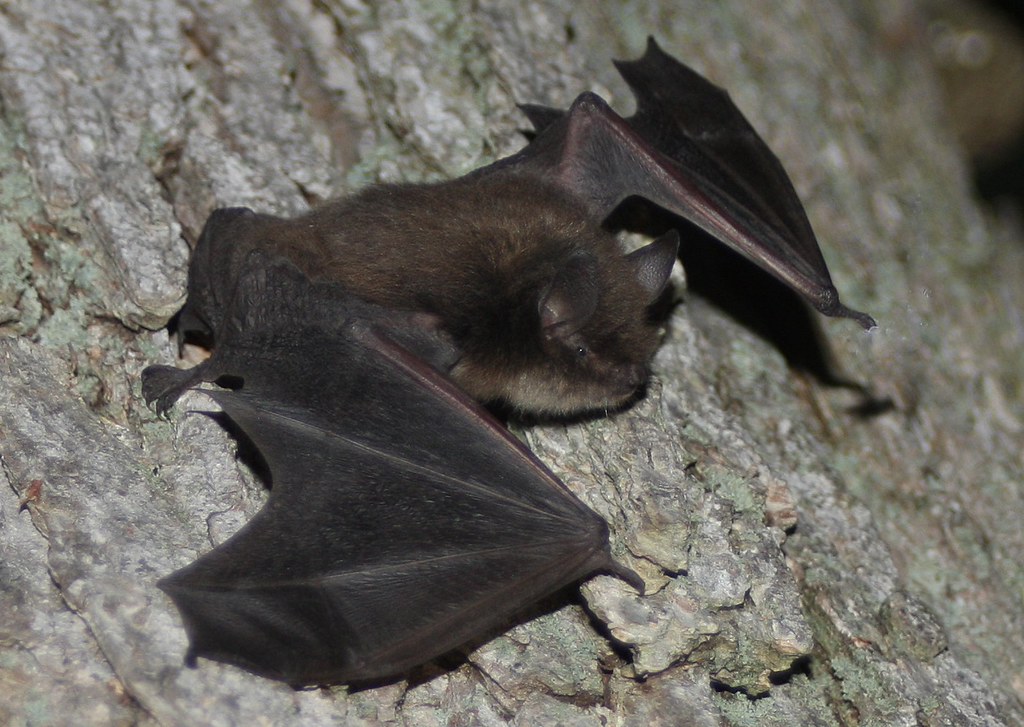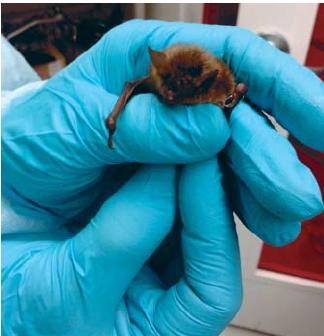Secret Health Benefits of Being a Bat
Blog post by Jasmin Skinner
Do you want to live healthier, longer? Have you considered ditching your heavy and clumsy human form for the wickedly fast body of a bat?
While scientifically impossible, this easy fix could help you live a longer life. Despite the common misconception that bats are dirty, disease-ridden animals, these winged mammals have extraordinary physiological adaptations that enable them to sustain extensive colonies of up to 183,500 individuals, typically with little risk of disease outbreak [1]. Different bat genera exhibit unique longevity strategies, yet it is the remarkable anti-aging abilities of the Myotis genus, commonly referred to as mouse-eared bats, that have particularly captivated researchers. Despite their small stature, Myotis bats are able to live up to 31 years, and yet rarely experience the standard mammalian age-related health effects [2]. Recent studies have linked aging with a wide variety of irreversible physiological changes – on both macro- and microscopic scales. Specifically, aging has been demonstrated to impact genomic instability, telomere dysfunction, mitochondrial dysfunction, cellular senescence, stem cell exhaustion, altered intercellular communication, as well as deregulated nutrient sensing [3].
As Myotis bats’ experience local extinction and population decline across the Eastern United States, characterizing their health- and age-related mechanisms becomes increasingly urgent, not just for scientific advancement, but for the continued survival of this essential species [4]. While the cause of this decline is invariably anthropogenically caused, this blog discusses how exactly these bats are able to live such long lives and tolerate infectious diseases.
The Little Brown Bat vs. Biology
The little brown bat, pictured on the left, is a frequent flier across most of Canada and the United States, typically growing to about 8-11 inches in wingspan [2]. Smaller animals typically live shorter lives than larger ones with some individuals in the wild reportedly living up to 31 years, although most average at around six and a half years [2]. This long lifespan appears to be related to their telomeres – repetitive sequences of DNA found at the end of chromosomes. Given the millions of cell divisions happening across an organism’s body, a small portion of information will be lost after replication, just due to the nature of this process [5]. Telomeres provide a buffer region for this process, allowing non-coding DNA to be lost in lieu of important genetic information [5].
Humans tend to age fairly predictably; with telomeres shortening with age. While this non-coding DNA can buffer the loss of coding DNA for a while, there is a limited number of times cells can divide before genetic information begins to be lost – known as the Hayflick limit [6]. Of the mechanisms that can maintain the length of these telomeres, the most widely known is telomerase. Telomerase adds pieces of DNA in cells that need to divide a lot, such as germ or stem cells [5]. However, this enzyme is part of the reason why cancer cells are able to grow and divide rapidly and avoid death, as they never reach their Hayflick limit [6].
In bats, specifically the Myotis family, relative telomere length is not at all related to age.
The members of this mouse-eared bat family, including the little brown bat, have developed another strategy for maintaining their genetic information known as alternative telomere lengthening (ATL). Although the mechanism of ATL is not entirely known, a 2018 publication from Foley et al. identified 21 telomere maintenance genes that are expressed differentially across the Myotis genus. Of these, 14 genes are specified for DNA repair, with only five being associated with alternative telomere-lengthening mechanisms [7]. Of this list, 20 of these genes are upregulated, including ATM and SETX which appear to be under divergent selection within Myotis. Both genes are key players in the DNA repair processes. Phan et al. found that ATM plays a crucial role as one of the “most critical initiators and coordinators of the DNA-damage response,” [8] while Richard et al. showed that SETX is involved in “implicated in transcriptional regulation and the DNA damage response through resolution of R-loop structures” [9] The singular downregulated gene identified was TEN1, and while limited research on the function of this gene is available, a 2001 study from Grandin et al. suggest that TEN1 is required to regulate telomere length [10]. The potential evolutionary divergence of alternative telomere lengthening strategies in Myotis provides an interesting framework through which to understand the variety of ways telomere lengthening could occur.
While rarely expressed in most cells, telomerase is expressed in 90% of cancer cells, and therefore finding alternative methods of lengthening and maintaining telomeres could be immensely important for providing additional treatments to resistant or aggressive cancers [7]. Additionally, researchers studying human diseases associated with aging could draw insights from the longevity of bats, with a 2023 study from Li et al. demonstrating how EPAS1, a well-defined oxygen response gene, was able to confirm expression of EPAS1 between bat fibroblasts and human pulmonary endothelial cells. Using in vitro-cultured human pulmonary endothelial cells, the authors demonstrated conservation of functional and mechanistic effects of EPAS1 in telomeric protection between bats and humans [11]. By demonstrating functional conservation of EPAS1, the authors have shown a clear link between human and Myotis cellular function, potentially inspiring future methods of disease management and treatment.
Long-lived vampires or immune to inflammation?
Longevity, while important, is certainly not what bats are best known for. Second to their vampiric reputation, the ability of the Myotis family to harbor a variety of inflammatory diseases without physical detriment is one of their most fascinating abilities [12]. The disease repertoire of bats is due to the special abilities of their inflammasomes, an intermediary sensor that is involved in the induction of inflammation in response to infectious microbes and molecules. It is unclear whether this asymptomatic hosting of viruses is related to the long lifespans of myotis, but a 2019 study from Ahn et al. demonstrates that an important inflammasome sensor, NLRP3, has implications in both viral-induced and age-related inflammation [13]. This sensor is crucial for recognizing the cellular stresses, such as mitochondrial damage and oxidized DNA, and has also been recognized for its role in mediating host response to multiple viruses. The authors of this study report dampened activation of bat NLRP3 inflammasome sensors in primary immune cells compared to mouse and human-related immune counterparts. The decrease in inflammation, as observed, did not affect the total viral load, even though the RNA viruses involved – MERS, SARS, and Ebola – are known for their severe pathogenicity in humans and typically provoke strong innate immune reactions.
Despite high viral loads in tissues and blood coagulates, bats exhibited little to no signs of disease, demonstrating their abilities to harbor a higher proportion of zoonotic diseases compared to other mammalian orders [13]. This ability to suppress inflammation despite high viral loads is also observed in relation to COVID-19, with the bat-specific binding molecule of SARS-CoV-2, Bat ASC-2, dampening inflammasome activity and inflammatory disease [13]. Inflammasome regulation has also been demonstrated to determine the severity of SARS-CoV-2 infection in humans as well as the innate immune tolerance of bats. Nagaraja et al. further confirmed the bat immune system’s unique adaptation in suppressing NLRP3 inflammasome activation and proinflammatory responses, highlighting the sophistication of the inflammatory immune response within Myotis [14].
Conclusions and future directions
The study of bats, particularly the Myotis genus, offers remarkable insights into longevity and disease resistance, with implications extending far beyond mere biological curiosity. These winged mammals, often misconceived as harbingers of disease, actually present a unique model for understanding aging, immune response mechanisms, as well as echolocation and sensory integration [15]. Their extraordinary ability to maintain telomere length through alternative mechanisms, in addition to their unique immune system that allows them to host various pathogens without detriment, opens new avenues for biomedical research. This research is not only critical for conserving these vital species but also has the potential to revolutionize current approaches to human age-related diseases and immune responses. The little brown bat, as a Myotis member, exemplifies these qualities, challenging the existing understanding of biology and pointing towards novel methods of addressing human health issues. As further conservation and research efforts provide more information about this unique taxa, the possibility of translating their natural defenses into treatments for human ailments becomes closer to a reality, highlighting the importance of preserving and studying wildlife.
About the Author
About the Author

Jasmin Skinner is an undergraduate student at the University of Western Ontario completing a Specialization in Biology and a Minor in Chemistry, with focused interest in applying these concepts to environmental conservation. After graduating, she hopes to continue her passion of finding unconventional solutions to environmental issues by working with nature, not against it.
References
References:[1] Langwig KE, Frick WF, Bried JT, Hicks AC, Kunz TH, Marm Kilpatrick A. Sociality,
density‐dependence and microclimates determine the persistence of populations suffering
from a novel fungal disease, white‐nose syndrome. Ecology Letters. 2012;15(9):1050–7.
doi:10.1111/j.1461-0248.2012.01829.x[2]Little Brown Bat [Internet]. [cited 2023 Nov 30]. Available from:
https://www.nwf.org/Educational-Resources/Wildlife-Guide/Mammals/Bats/Little-Brown-Bat#:
~:text=On%20 average%2C%20little%20 brown%20
bats,northern%20United%20States%20into%20Canada.[3] Guo J, Huang X, Dou L, Yan M, Shen T, Tang W, Li J. Aging and aging-related diseases: from molecular mechanisms to interventions and treatments. Signal Transduction and Targeted Therapy. 2022;7:391. Doi: 10.1038/s41392-022-01251-0[4] Canada E and CC. Government of Canada [Internet]. / Gouvernement du Canada; 2012[cited 2023 Nov 30]. Available from:
https://www.canada.ca/en/environment-climate-change/services/species-risk-public-registry/
cosewic-assessments/little-brown-myotis-technical-summary-2012.html#_tbl02[5] Telomere [Internet]. [cited 2023 Nov 30]. Available from:
https://www.genome.gov/genetics-glossary/Telomere[6] Shay JW, Wright WE. Hayflick, his limit, and cellular ageing. Nature Reviews Molecular
Cell Biology. 2000;1(1):72–6. doi:10.1038/35036093[7] Foley NM, Hughes GM, Huang Z, Clarke M, Jebb D, Whelan CV, et al. Growing old, yet
staying young: The role of telomeres in bats’ exceptional longevity. Science Advances.
2018;4(2). doi:10.1126/sciadv.aao0926[8] Phan LM, Rezaeian AH. ATM: Main Features, Signaling Pathways, and Its Diverse Roles in DNA Damage Response, Tumor Suppression, and Cancer Development. Genes (Basel). 2021; 12(6): 845. doi: 10.3390/genes12060845[9] Richard P, Feng S, Tsai YL, Li W, Rinchetti P, Muhith U, Irizarry-Col J, Stolz K, Sanz LA, Hartono S, Hoque M, Tadesse S, Seitz H, Lotti F, Hirano M, Chédin F, Tian B, Manley JL. SETX (senataxin), the helicase mutated in AOA2 and ALS4, functions in autophagy regulation. Autophagy. 2021;17(8):1889-1906. doi: 10.1080/15548627.2020.1796292[10] Grandin N, Damon C, Charbonneau M. Ten1 functions in telomere end protection and length regulation in association with Stn1 and Cdc13. EMBO J. 2001;20(5): 1173-83. doi: 10.1093/emboj/20.5.1173[11] Guo H, Callaway JB, Ting JPY. Inflammasomes: Mechanism of Action, Role in Disease, and Therapeutics. Nat Med. 2015;21(7):677-87. doi:10.1038/nm.3893.[12] Li KQ, Liu GJ, Liu XY, Chen QF, Huang XY, Tu Q, Zhang J, Chang Q, Xie YH, Hua R, Xu DM, Liu Z, Zhao B. EPAS1 prevents telomeric damage-induced senescence by enhancing transcription of TRF1, TRF2, and RAD50. 2023; 44(3):636-49. doi: 10.24272/j.issn.2095-8137.2022.531.[13] Ahn M, Anderson DE, Zhang Q, Tan CW, Lim BL, Luko K, Wen M, Chia WN, Mani S, Wang LC, Jiang JH, Sobota RM, Dutertre CA, Ginhoux F, Shi ZL, Irving AT, Wang LF. Dampened NLRP3-mediated inflammation in bats and implications for a special viral reservoir host. Nature Microbiology. 2019;4:789-99.[14] Nagaraja S, Jain D, Kesavardhana S. Inflammasome regulation in driving COVID-19 severity in humans and immune tolerance in bats. J. Leukoc Biol. 2022; 111(2):497-508. doi: 10.1002/JLB.4COVHR0221-093RR.[15] Hooper SE & Amelon SK. Handling and blood collection in the little brown bat (Myotis lucifugus). Clinical Techniques. 2014;43:197-9. doi:10.1038/laban.543

